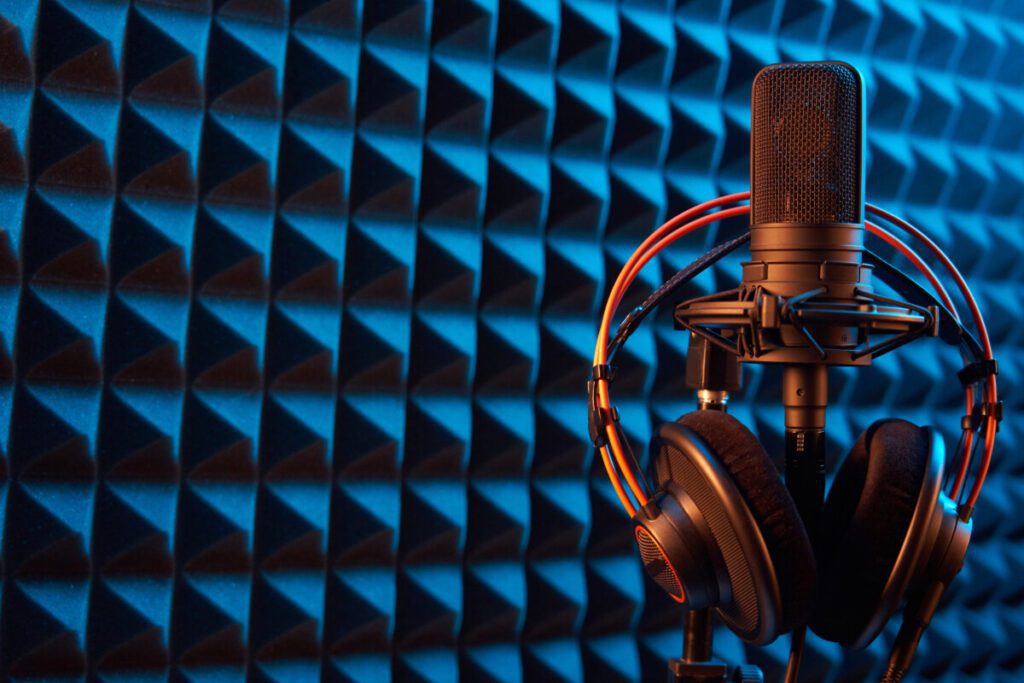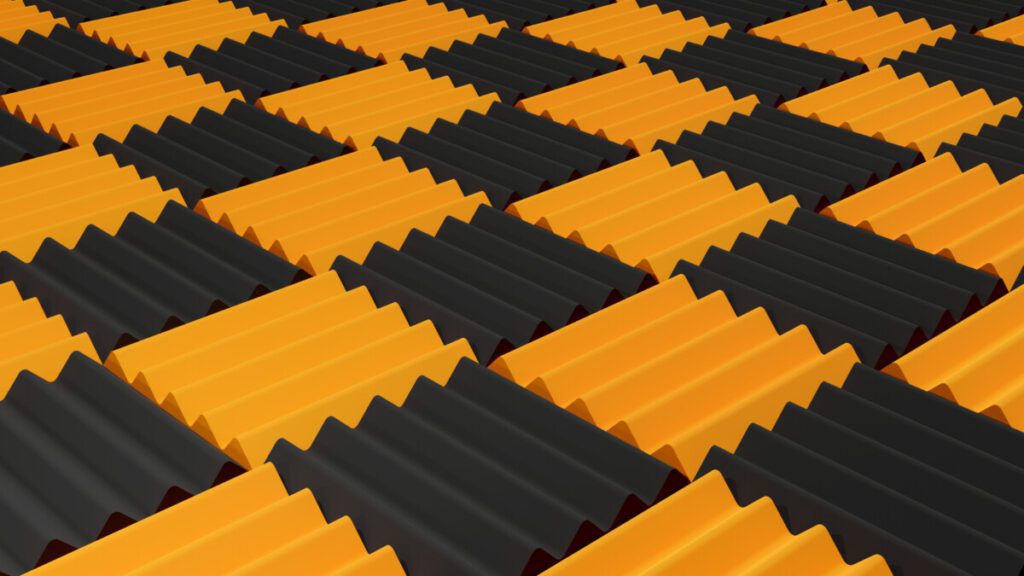Setting up a recording space or theater room at home can be complicated if you aren’t already acquainted with all the little intricacies of acoustics.
There are two kinds of acoustic work you can do in a room. The first is sound blocking, which stops sounds outside from getting into the room. The second is sound absorbing, which stops sounds that originate in the room from reverberating. Foam panels can only be used for sound absorption.
But why are foam panels bad for sound blocking? And what is the correct use case for a set of acoustic foam panels?
Table of Contents
- Sound Blocking Vs. Sound Absorbing Acoustic Panels
- When To Use Acoustic Foam Panels
- How To Install Acoustic Foam Panels
- How Are Acoustic Foam Panels Measured?
- What Acoustic Treatment Panels To Use
Sound Blocking Vs. Sound Absorbing Acoustic Panels
Sound is nothing more than a wave of energy that pushes through the air. It is caused whenever an object vibrates enough to push the air around it. It travels through solid objects just like it does gases and is stopped by things that won’t vibrate.
Notice that foam is an object that won’t vibrate. Sound passes through foam just fine, meaning that no matter how many foam panels are on a wall, sounds will still enter the room from the other side, which can be the root of many recording problems.
To block sound from outside of a room, you need to place an object that is dense enough that the sound won’t be able to travel through it in between yourself and outside. This can be specially engineered vinyl or even drywall, but it probably shouldn’t be foam.
What foam paneling does is stop sound from reflecting off a hard surface. When it comes to sound, you can think of hard surfaces like walls, desks, and floors like mirrors that will reflect noises back at their sources. The thing we’re trying to stop isn’t the sound traveling into the object but bouncing off of it.
Acoustic foam paneling makes it difficult for the sound to travel to the wall in the first place by absorbing the energy from the wave the same way it would absorb the energy from a punch. Sound will travel through the foam just fine, but it won’t bounce as it would off of a wall.
When To Use Acoustic Foam Panels
Acoustic foam panels are at their best when used strategically to stop echoes alongside other sound blocking and absorbing devices. A simple, breathable cloth will be enough to absorb the worst of the sound on most surfaces.
Acoustic Foam panels should be placed in corners of recording studios, across from speakers, and around the origin point of any sound you are recording, be they a vocalist or an instrument. This will allow them to catch the sounds that would be reflected back into the microphone and significantly decreases room coloration in recording studios.
A clever trick for figuring out where you need to place acoustic panels is to take the microphone and look for the parts of the room where you can see it from the wall through a mirror.
These are the places from which sound is most likely to be reflected directly towards the microphone and are thus the places where it’s most important to make sure the sound isn’t reflecting as much in recording studios.
Do this for speakers and vocalists to find the spots that will get the most directly sound-blasted.
You also may be able to tell where the biggest echoes are just by listening. If there’s one wall that’s especially large compared to the other ones, or when you speak you can hear an echo coming from one particular corner of the room, those might be places that you want to put paneling on.
Make sure to have all this planning done before you start buying acoustic panels, as acoustic panels can be costly. You don’t want to accidentally buy too few or too many.
Fortunately, if you start the planning phase before you buy you should be able to avoid this.
Soundproofing foam panels probably shouldn’t be the first step when preparing a studio. You should probably save them for after the walls have been prepped with something to block out outside noise.
How To Install Acoustic Foam Panels
While acoustic panels aren’t needed all over your walls, they are also fortunately fairly easy to install. To put up individual panels, all you’ll need is something to fix them to the wall. While spray glue or long tacks can work, they will cause permanent wall damage as well.
Double-sided mounting tape is a much safer option and can be applied directly to a panel without the worry of damaging it or the wall.
A single panel probably doesn’t need more than a couple of pieces of tape, as they aren’t especially heavy. If you’re putting up a few panels in a small room, this might be all you have to do.
If you need to put up more panels at a time, you can use a poster board as a backboard for them. Using hot glue or its equivalent, affix up to six panels per board.
If the panels you’re using have directional grooves, it’s best practice to make sure they aren’t all facing the same way.
You can then hang the posterboard on the wall with some mounting tape, although the weight of the board combined with the weight of the soundproofing foam panels will necessitate a stronger grade of tape than what you would use for individual panels.
In this case, you can probably use mounting tape meant for hanging heavy picture frames.
How Are Acoustic Foam Panels Measured?

Acoustic foam panels are measured based on their NRC, which stands for “Noise Reduction Coefficient.” This is how much of the ambient sound a panel can absorb. NRCs go from 0 to 1, with an NRC of 0 being an object that absorbs no sound and an object with an NRC of 1 being one that will absorb all sounds that hit it.
A good NRC for a small home studio is somewhere between 0.7 and 0.9. For a small room, you probably don’t need those super high-NRC panels that claim to absorb 97% of sounds, you just need something that will get most of the ambient noise before it reflects back to you.
For any given panel the NRC will vary depending on the frequency of the sound that hits it. Most sound-absorbing panels have very low NRCs at the range where people like to speak, and that increases as you approach 500hrtz, the range where a lot of background noise tends to sit.
This is the most important range to absorb.
For larger rooms that are naturally more echoey, a higher NRC will be more useful. In general, if the room you’re converting has space for a whole band in it you’ll probably want something with an NRC higher than 0.9.
Some people mistake high NRC tiles for being able to suck sounds out of the air. The fact of the matter is that acoustic foam paneling can only absorb sounds that actually hit the tile, meaning that the panel can’t stop sounds entirely, just echoes. Because of this, you shouldn’t be afraid of high NRC panels.
They won’t magically make your room silent, they’ll just reduce background noise that originates from inside the room.
What Acoustic Treatment Panels To Use
Keeping in mind that the acoustic foam panels we’re talking about here will probably not have very much functionality for sound-blocking and that they are best used strategically, here are some brands that are generally pretty effective for the jobs they are intended to complete.
Foamily Egg Crate Acoustic Panels
These budget acoustic panels are fine. We’re starting out with them because there are some obvious problems with them that make them poor candidates for a professional home studio for recording music in particular.
They are large and indivisible, which makes them difficult to hang up in harder-to-reach parts of the room. While you could cut them up, this seems like a solution that could easily end in disaster if you cut a piece the wrong size.
While these panels are certainly cheaper than their contemporaries, they are still very expensive and wasting a lot of it trying to get a strip the right size seems like it could easily end up costing you more than it would to just buy nicer panels.
They also have this weird thing going on where their Amazon page just says “High-quality NRC!” on it without actually listing the NRC.
This is probably fine as the NRC that you need for a small room is probably not all that high, but I would be wary of putting this in a larger room that will naturally have more echoes. “High-quality NRC” may not mean very much at all.
However, the price is still very low and the panels are effective at absorbing sound, which might be enough to make up for the bulkiness, especially if you’re the kind of person who likes putting projects together on their own.
While it may not be perfect, it’s probably the best low-cost option out there.
Auralex Acoustics Studiofoam Wedgies Acoustic Absorption Foam
These more expensive panels come with a significant increase in quality and in modularity. In fact, these panels are the exact opposite of the Foamily Egg Crate panels, as they are only one square foot each, allowing them to be placed even in very small specific places without needing them to be cut up.
This is a pretty big advantage when location is everything. If you’re in a small or medium-sized room these will work best, especially considering their NRC which comes in a range of 0.75 to 0.8.
Audiomute Acousticolor Acoustic Tiles
These acoustic foam panels are remarkable mostly for their bright colors. Whatever aesthetic you’re looking for, if it isn’t either grey or white then these tiles should be able to do it for you.
Like the Auralex, these panels come in very small sizes if you need those. They also have an incredibly high NRC of 0.95, which is absolutely wild. These things are suitable for use in any room but can work in any room that you want.
They also come in a variety of sizes, which gives them a similar manipulability to the Auralex. The biggest problem with these particular tiles is the price, as they cost about twenty-five dollars per square foot of panels.
However, if you place these carefully in a small space you can probably get enough to cover everything you need for only a couple hundred dollars.

Soundassured Acoustic Studio Foam
With even the thickest offering being only half the cost of Audiomute’s tiles, these panels offer an alternative for people who are looking for more colorful panels but don’t want to spend six hundred dollars covering five square feet.
Unlike some of the other companies we’ve already talked about, Soundassured has the full range of their products’ NRCs on Amazon. While a quick examination shows that their one-inch-thick panels probably don’t have the absorptive properties we’re looking for.
Their two-inch-thick panels are perfect for catching sound in smaller rooms and their three-inch panels are great for larger rooms.
They also offer corner blocks bass traps, which are different from acoustic foam panels but equally important for creating a quality audio environment.
Mybecca Acoustic Panels
Mybecca’s acoustic panels are a great option that is pretty good for everyday noise reduction (or displaying knives, as one Amazon reviewer did) in a home environment.
While they do seem to reduce sound in a lot of rooms, they don’t list the NRC on the website or on the Amazon page and so it might not actually be very high.
That being said, they do offer a good variety of configurations, which may make it easier to find something to cover your weirdest walls.
However, most people who pick them up for a home studio end up disappointed. If you have a pocket-knife collection that you want to show off, I might have the product for you!
- Review of the ALABS IRON MINI-WL: A Powerhouse Wireless Microphone - October 4, 2023
- What is a Saturator in Music Production: A Brief Explanation - May 11, 2023
- What Are Rotary DJ Mixers? An Overview - May 11, 2023
SoundStudiomagic.com is a participant in the Amazon Services LLC Associates Program, an affiliate advertising program designed to provide a means for sites to earn advertising fees by advertising and linking to Amazon.com. We also participate in other affiliate programs which compensate us for referring traffic.






